Experimental and Simulation Research on Straight-Through Cyclone Water Separator: Effects of Structural and Operational Parameters on Separation Performance
Abstract
1. Introduction
2. Experimental Design
2.1. Experimental Platform
2.2. Experimental Conditions
2.2.1. Structural Parameters
2.2.2. Operating Parameters
2.3. Data Processing
2.3.1. Parameter Calculation
2.3.2. Uncertainty Analysis
3. Numerical Methods
3.1. Physical Model and Boundary Conditions
3.2. Governing Equations and Turbulence Model
3.3. Discrete Phase Model
3.4. Simulation and Solution Methods
3.5. Grid-Independence Verification
4. Results
4.1. Analysis of Internal Flow Characteristics of the Separator
4.2. Analysis of Separation Efficiency
4.2.1. Effect of Different Air Mass Flow Rates
4.2.2. Effect of Different Humidification Rates
4.3. Comparative Simulation Analysis Under High-Pressure and Low-Pressure Conditions
5. Conclusions and Discussion
- Separation efficiency exhibits a non-monotonic dependence on air mass flow rate, following a “rise–fall–rise” trend. This behavior arises from the competition and transition among multiple mechanisms, including centrifugal separation, turbulence-induced secondary entrainment of droplets, and the tendency of the flow field to become relatively stabilized at higher flow rates.
- Swirl angle is the key parameter governing the flow-field structure and separation performance. A 20° swirl angle generates stronger swirl and reaches the efficiency peak more rapidly at low air mass flow rates; however, it also intensifies turbulent dissipation, resulting in a pronounced increase in pressure loss and an earlier onset of flow instability at lower Re. Over portions of the flow-rate range, the 30° swirl generator attains a stable, strongly turbulent state earlier and achieves higher separation efficiency than the 40° swirl generator. Nonetheless, in aggregate, the 40° swirl angle delivers superior overall performance across a wider range of air mass flow rates.
- The high-pressure water separator outperforms its low-pressure counterpart. Increasing operating pressure significantly enhances separation performance (with an efficiency improvement of approximately 30.7%) while reducing pressure loss. High pressure suppresses gas velocity, yielding a more uniform flow field, effectively diminishing gas carry-under losses, and promoting stable droplet attachment and collection along the wall.
Author Contributions
Funding
Data Availability Statement
Acknowledgments
Conflicts of Interest
Abbreviations
| ACS | Aircraft Air-cycle System |
| DPM | Discrete Phase Model |
| RSM | Reynolds Stress Model |
| CFD | Computational Fluid Dynamics |
| Re | Reynolds Number |
| K | Pressure loss coefficient |
| St | Strouhal Number |
References
- Liao, J.; Yang, C.; Yang, H. Evaluation of Aircraft Environmental Control System Order Degree and Component Centrality. Aerospace 2023, 10, 438. [Google Scholar] [CrossRef]
- Scott, T.J.A.; Jacob, C.; Cheng, F.; Manasseh, R.; Leontini, J.S. Global instability of flows through single- and double-bifurcation airway models. J. Fluid Mech. 2025, 1020, A32. [Google Scholar] [CrossRef]
- Yang, L.; Chen, X.; Huang, C.; Liu, S.; Ning, B.; Wang, K. A review of gas-liquid separation technologies: Separation mechanism, application scope, research status, and development prospects. Chem. Eng. Res. Des. Trans. Inst. Chem. Eng. 2024, 201, 257–274. [Google Scholar] [CrossRef]
- Yuan, T.; Wang, C.; Chen, M.; Yang, F.; Hou, Y.; Ma, L.; Duan, Z.; Che, D. Simulation investigation on separation characteristics of gas-liquid model products from in-situ pyrolysis of tar-rich coal. J. Environ. Chem. Eng. 2025, 13, 115719. [Google Scholar] [CrossRef]
- Liu, L.; Bai, B. Scaling laws for gas–liquid flow in swirl vane separators. Nucl. Eng. Des. 2016, 298, 229–239. [Google Scholar] [CrossRef]
- Movafaghian, S.; Jaua-Marturet, J.A.; Mohan, R.S.; Shoham, O.; Kouba, G.E. The effects of geometry, fluid properties and pressure on the hydrodynamics of gas-liquid cylindrical cyclone separators. Int. J. Multiph. Flow 2000, 26, 999–1018. [Google Scholar] [CrossRef]
- Kataoka, H.; Shinkai, Y.; Hosokawa, S.; Tomiyama, A. Swirling annular flow in a steam separator. J. Eng. Gas Turbines Power 2009, 131, 032904. [Google Scholar] [CrossRef]
- Mao, Y.; Pu, W.; Zhang, H.; Zhang, Q.; Song, Z.; Chen, K.; Han, D. Orthogonal experimental design of an axial flow cyclone separator. Chem. Eng. Process. 2019, 144, 107645. [Google Scholar] [CrossRef]
- Sun, Z.; Li, J.; Sun, M.; Wang, Z. Study of flow characteristics in straight-flow gas-liquid cyclone separator. Chem. Eng. Res. Des. Trans. Inst. Chem. Eng. 2025, 219, 100–119. [Google Scholar] [CrossRef]
- Matsubayashi, T.; Katono, K.; Hayashi, K.; Tomiyama, A. Effects of swirler shape on swirling annular flow in a gas-liquid separator. Nucl. Eng. Des. 2012, 249, 63–70. [Google Scholar] [CrossRef]
- Fu, S.; Tao, L.; Shen, Z.; Xu, M.; Yang, D.; Hu, Y.; Zhou, F. Effects of helical guide vanes on droplet behavior and separation performance in gas-liquid separators. Chem. Eng. Process.—Process Intensif. 2025, 209, 110197. [Google Scholar] [CrossRef]
- Qiu, Z.; Zhou, L.; Bai, L.; El-Emam, M.A.; Agarwal, R. Empirical and numerical advancements in gas-liquid separation technology: A review. Geoenergy Sci. Eng. 2024, 233, 212577. [Google Scholar] [CrossRef]
- Zhang, Y.; Li, K.; Zhang, K.; Zhu, G.; Sun, Z.; Shi, J. Research on the flow field characteristics of the industrial elliptical cyclone separator. Separations 2025, 12, 50. [Google Scholar] [CrossRef]
- Tang, Y.; Qiao, Z.; Cao, Y.; Si, F.; Romero, C.E.; Rubio-Maya, C. Numerical analysis of separation performance of an axial-flow cyclone for supercritical CO2-water separation in CO2 plume geothermal systems. Sep. Purif. Technol. 2020, 248, 116999. [Google Scholar] [CrossRef]
- Liu, X.; Liu, Z.; Li, Y. Investigation on separation efficiency in supersonic separator with gas-droplet flow based on DPM approach. Sep. Sci. Technol. 2014, 49, 2603–2612. [Google Scholar] [CrossRef]
- Wang, Z.H. Separation Mechanism and Experimental Research of High Pressure Water Separator. Master’s Thesis, Beihang University, Beijing, China, 1992. (In Chinese). [Google Scholar]
- Dang, C.B. Performance Research of High Pressure Water Separator. Ph.D. Thesis, Beihang University, Beijing, China, 1997. (In Chinese). [Google Scholar]
- Yang, C.X.; Yuan, X.G.; Wang, Z.H. Experimental research on high pressure water separator. Fluid Eng. 1991, 21, 13–15. (In Chinese) [Google Scholar]
- Chen, L.; Zhang, X.; Wang, C.; Yang, C. Analysis on high-pressure water separator. Procedia Eng. 2015, 121, 558–566. [Google Scholar] [CrossRef]
- Li, Q.; Xu, W.; Wang, J.; Jin, Y. Performance evaluation of a new cyclone separator—Part I: Experimental results. Sep. Purif. Technol. 2015, 141, 375–388. [Google Scholar] [CrossRef]
- Alduchov, O.A.; Eskridge, R.E. Improved Magnus form approximation of saturation vapor pressure. J. Appl. Meteorol. 1996, 35, 601–609. [Google Scholar] [CrossRef]
- Moffat, R.J. Describing the uncertainties in experimental results. Exp. Therm. Fluid Sci. 1988, 1, 3–17. [Google Scholar] [CrossRef]
- Holman, J.P. Experimental Methods for Engineers, 8th ed.; McGraw-Hill Education: Boston, MA, USA, 2011; pp. 132–134. [Google Scholar]
- Feng, J.; Chang, Y.; Peng, X.; Qu, Z. Investigation of the oil-gas separation in a horizontal separator for oil-injected compressor units. Proc. Inst. Mech. Eng. Part A J. Power Energy 2008, 222, 403–412. [Google Scholar] [CrossRef]
- Escue, A.; Cui, J. Comparison of turbulence models in simulating swirling pipe flows. Appl. Math. Model. 2010, 34, 2840–2849. [Google Scholar] [CrossRef]
- Ding, H.; Sun, C.; Wang, C.; Wen, C.; Tian, Y. Prediction of dehydration performance of supersonic separator based on a multi-fluid model with heterogeneous condensation. Appl. Therm. Eng. 2020, 171, 115074. [Google Scholar] [CrossRef]
- Wang, Z.; Jin, A.; Liu, M. Simulation and Experimental Design of an Axial Flow Cyclone Separator Suitable for High-Wind–Sand Environments. Sustainability 2025, 17, 3355. [Google Scholar] [CrossRef]
- Kaya, M.N.; Satcunanathan, S.; Meinke, M.; Schröder, W. Leading-Edge Noise Mitigation on a Rod–Airfoil Configuration Using Regular and Irregular Leading-Edge Serrations. Appl. Sci. 2025, 15, 7822. [Google Scholar] [CrossRef]
- Ishak, M.H.H.; Ismail, F.; Mat, S.C.; Aziz, M.S.A.; Abdullah, M.Z.; Abas, A. Numerical study on the influence of nozzle spray shape on spray characteristics using diesel and biofuel blends. Biofuels 2019, 12, 1109–1121. [Google Scholar] [CrossRef]
- Hoffmann, A.C.; Stein, L.E.; Bradshaw, P. Gas Cyclones and Swirl Tubes: Principles, Design and Operation. Appl. Mech. Rev. 2003, 56, B28–B29. [Google Scholar] [CrossRef]
- Grimble, T.A.; Agarwal, A.; Juniper, M.P. Local linear stability analysis of cyclone separators. J. Fluid Mech. 2017, 816, 507–538. [Google Scholar] [CrossRef]







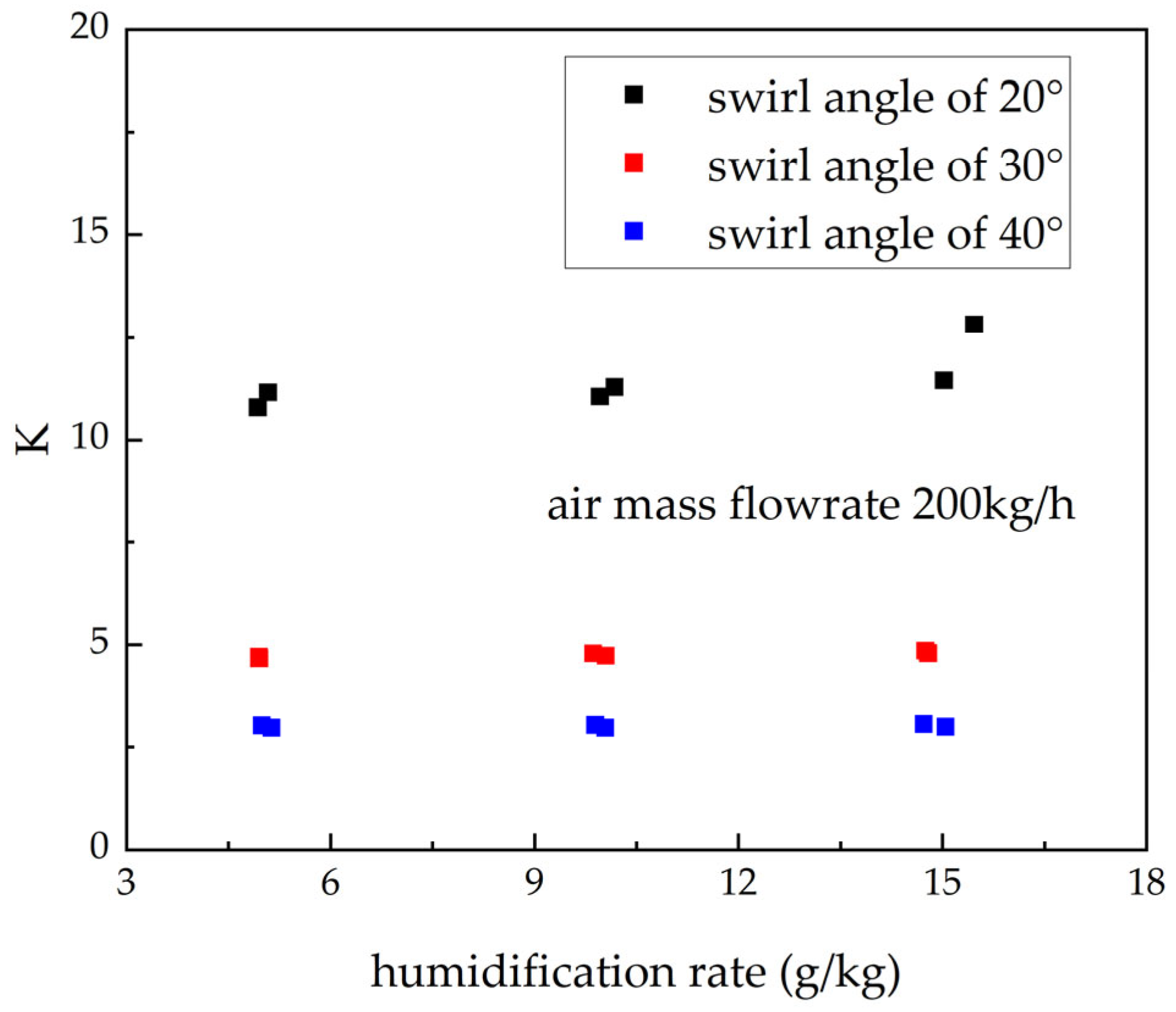
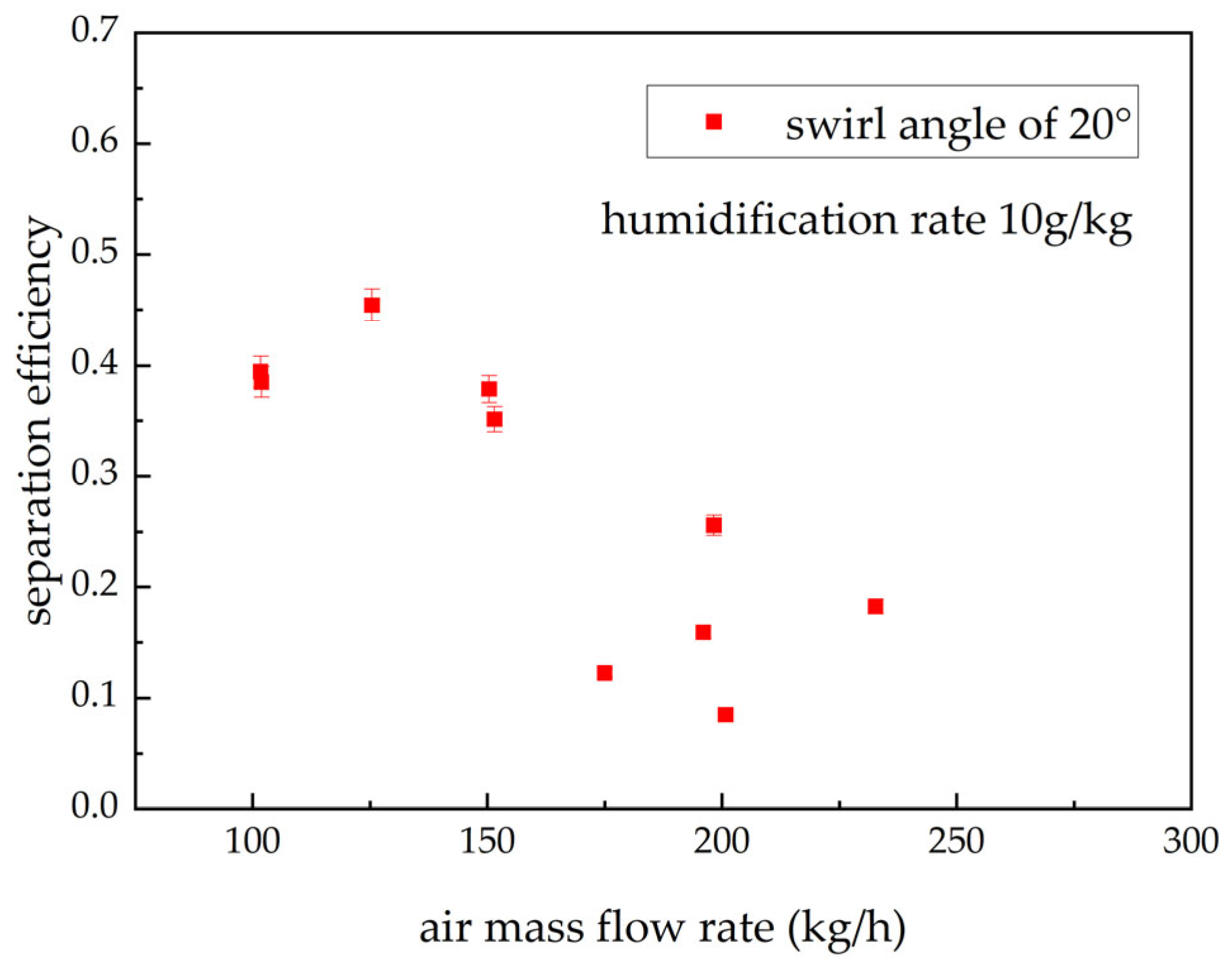
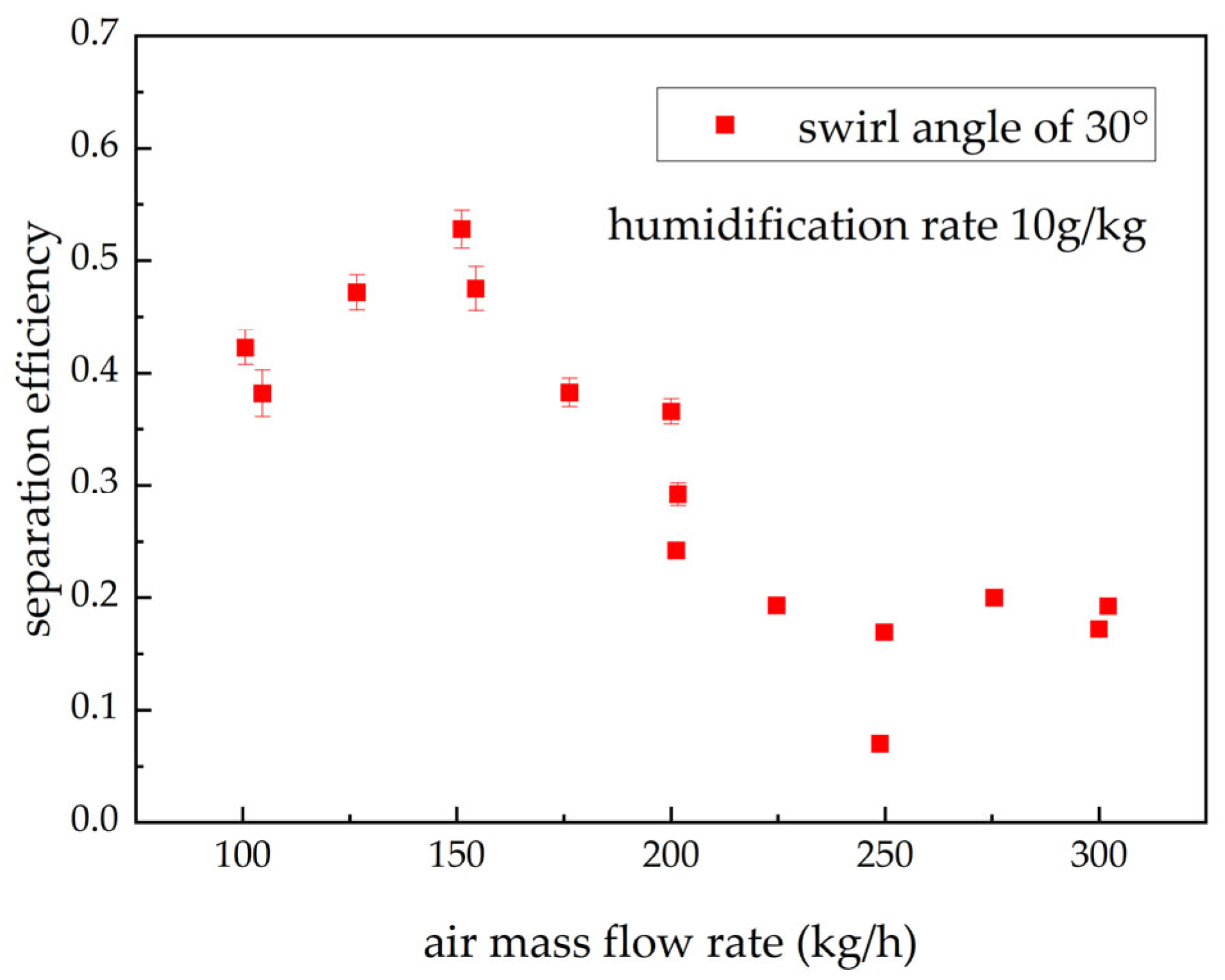
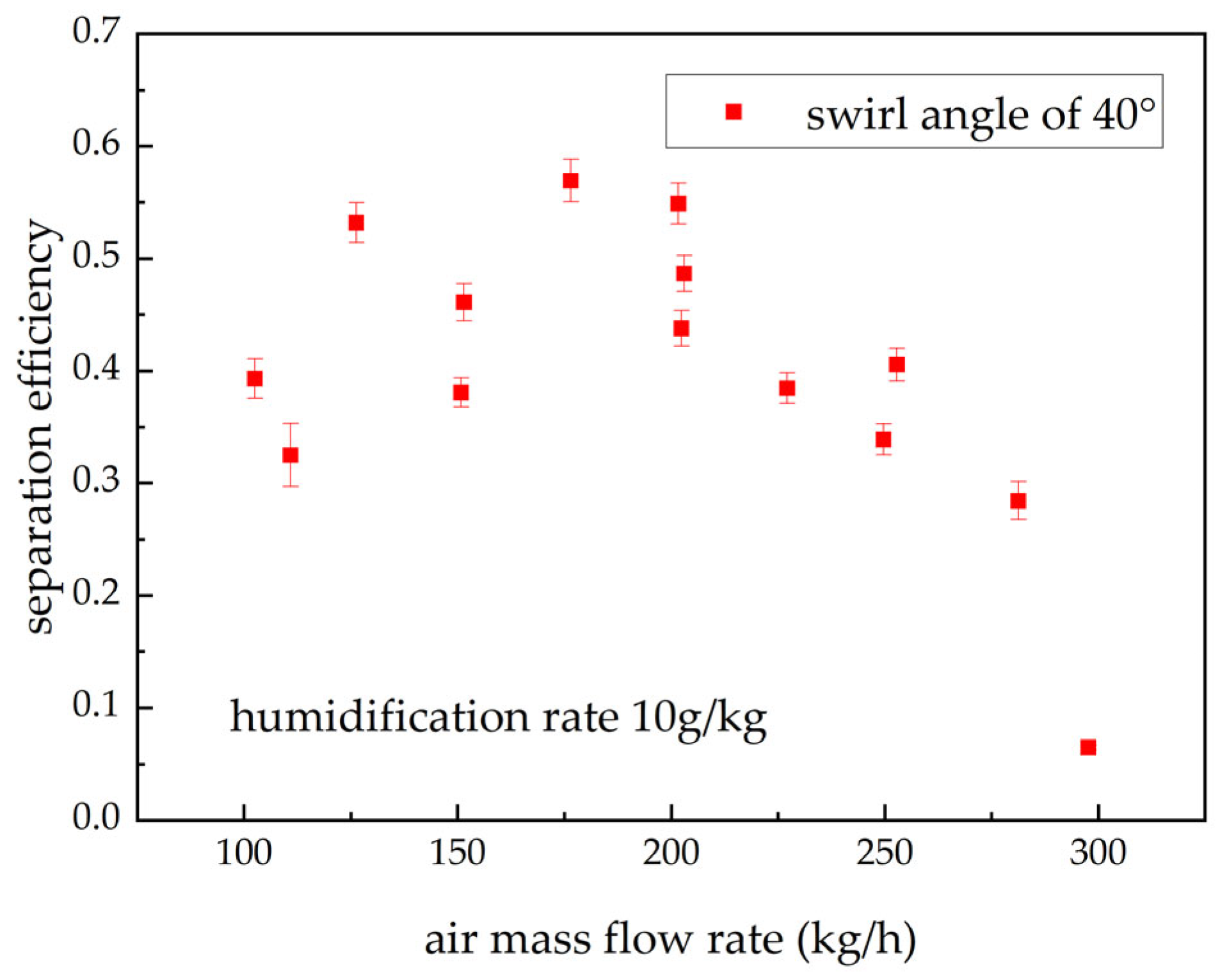

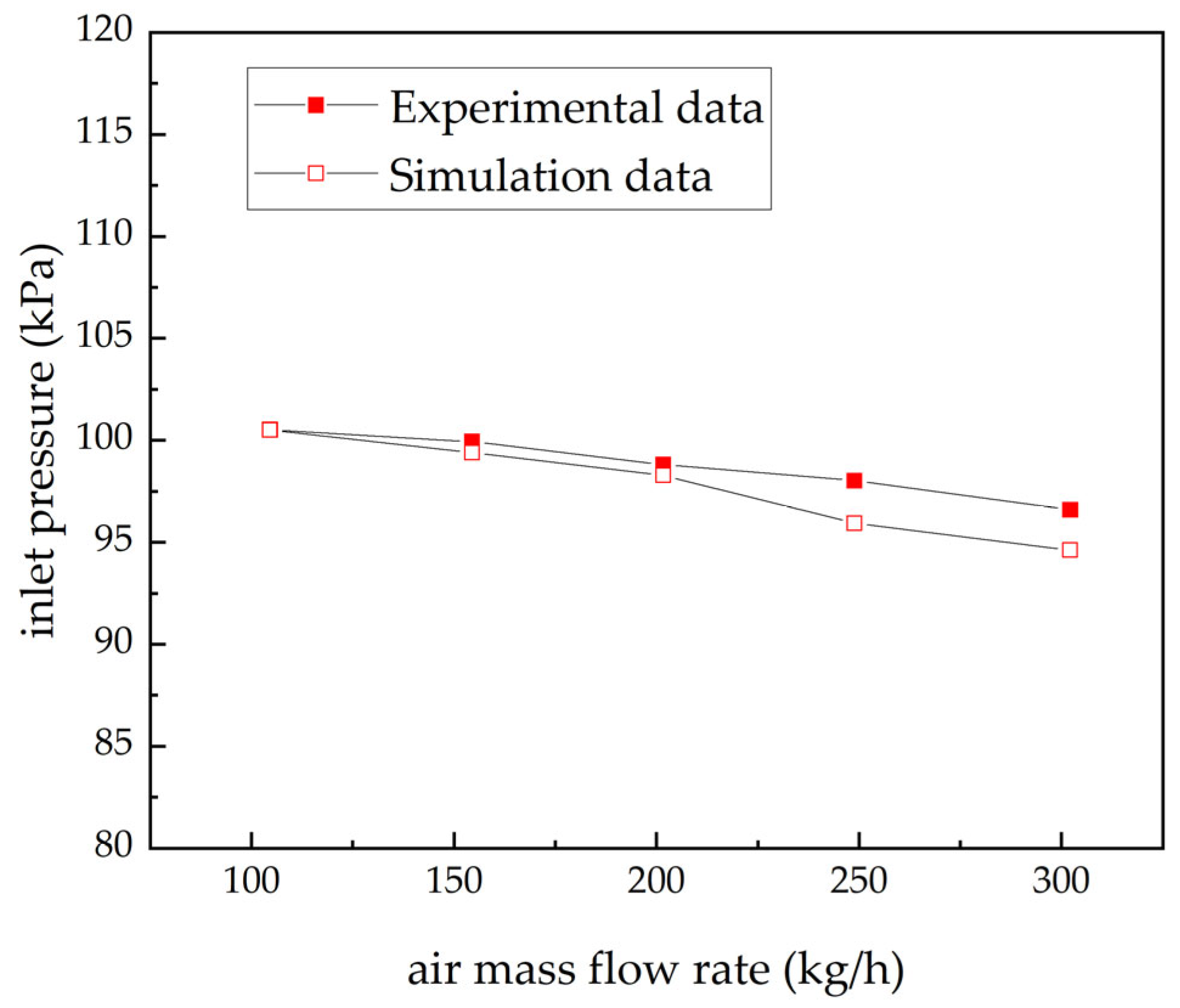




| Measurement Parameter | Equipment | Manufacturer | Model | Accuracy |
|---|---|---|---|---|
| Air mass flow rate | Vortex flowmeter | Hangzhou Meacon Automation Co., Ltd. (Hangzhou, China) | LUGB-SUP-DN100-C | ±1% |
| Injected liquid water mass flow rate | Mass flowmeter | Beijing Shouke Shihua Automation Equipment Co., Ltd. (Beijing, China) | DMF-1-IA | 0.2% |
| Separated water weight | Electronic balance | Hangzhou Jiachong Trading Co., Ltd. (Hangzhou, China) | YH-30 | ±1 g |
| Pressure | Pressure sensors | Suzhou Xuansheng Instrument Technology Co., Ltd. (Suzhou, China) | PGM300 | 0.2% FS |
| Temperature | Temperature sensors | Beijing Huakong Xingye Technology Development Co., Ltd. (Beijing, China) | HSTL-103F | ±0.25% |
| Temperature and humidity | Temperature-humidity sensors | Beijing Huakong Xingye Technology Development Co., Ltd. (Beijing, China) | HSTL-110WS | ±0.3 °C/±3% RH |
| Pressure loss across water separator | Differential pressure transmitter | Hangzhou Meacon Automation Co., Ltd. (Hangzhou, China) | SU-2051-D | ±0.075% |
| Data acquisition | Paperless recorder | Hangzhou Meacon Automation Co., Ltd. (Hangzhou, China) | SUP-R6000C, 50/60 Hz | Sampling interval of 1 s |
| Swirl Angle (°) | Pitch (mm) | Outer Diameter (mm) | Central Shaft Diameter (mm) | Axial Length (mm) | Number of Vanes |
|---|---|---|---|---|---|
| 20 | 43.5 | 38 | 5 | 35 | 4 |
| 30 | 69 | ||||
| 40 | 100 |
| Index | Air Mass Flow Rate (kg/h) | Humidification Rate (g/kg) | Swirl Angle (°) |
|---|---|---|---|
| 1 | 100 | 10 | 20, 30, 40 |
| 2 | 125 | 10 | 20, 30, 40 |
| 3 | 150 | 10 | 20, 30, 40 |
| 4 | 175 | 10 | 20, 30, 40 |
| 5 | 200 | 5 | 20, 30, 40 |
| 6 | 200 | 10 | 20, 30, 40 |
| 7 | 200 | 15 | 20, 30, 40 |
| 8 | 225 | 10 | 20, 30 |
| 9 | 250 | 10 | 20, 30 |
| 10 | 275 | 10 | 20, 30 |
| 11 | 300 | 10 | 20, 30 |
| Parameter | Relative Uncertainty |
|---|---|
| (kg/s) | 1% |
| (kg/s) | 0.2% |
| (°C) | 0.25% |
| (%) | 3–5.77% |
| (kPa) | 0.2–0.25% |
| (kPa) | 0.075% |
| (kg) | 0.2–1.2% |
| (g/kg) | 3.02–5.78% |
| 3.03–5.79% |
| Operating Condition | Inlet Pressure (kPa) | Outlet Pressure (kPa) | Pressure Loss (kPa) | Separation Efficiency |
|---|---|---|---|---|
| Experimental | 98.8 | 93.8 | 5 | 29.2% |
| Simulation | 98.3 | 93.8 | 4.5 | 28% |
Disclaimer/Publisher’s Note: The statements, opinions and data contained in all publications are solely those of the individual author(s) and contributor(s) and not of MDPI and/or the editor(s). MDPI and/or the editor(s) disclaim responsibility for any injury to people or property resulting from any ideas, methods, instructions or products referred to in the content. |
© 2025 by the authors. Licensee MDPI, Basel, Switzerland. This article is an open access article distributed under the terms and conditions of the Creative Commons Attribution (CC BY) license (https://creativecommons.org/licenses/by/4.0/).
Share and Cite
Chen, Y.; Zhang, X.; Wang, C.; Yang, H. Experimental and Simulation Research on Straight-Through Cyclone Water Separator: Effects of Structural and Operational Parameters on Separation Performance. Processes 2025, 13, 3732. https://doi.org/10.3390/pr13113732
Chen Y, Zhang X, Wang C, Yang H. Experimental and Simulation Research on Straight-Through Cyclone Water Separator: Effects of Structural and Operational Parameters on Separation Performance. Processes. 2025; 13(11):3732. https://doi.org/10.3390/pr13113732
Chicago/Turabian StyleChen, Yihan, Xingjuan Zhang, Chao Wang, and Han Yang. 2025. "Experimental and Simulation Research on Straight-Through Cyclone Water Separator: Effects of Structural and Operational Parameters on Separation Performance" Processes 13, no. 11: 3732. https://doi.org/10.3390/pr13113732
APA StyleChen, Y., Zhang, X., Wang, C., & Yang, H. (2025). Experimental and Simulation Research on Straight-Through Cyclone Water Separator: Effects of Structural and Operational Parameters on Separation Performance. Processes, 13(11), 3732. https://doi.org/10.3390/pr13113732





